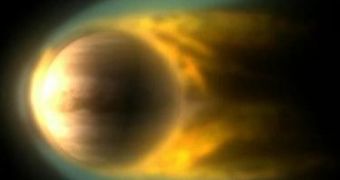Though Mars is most of the times considered Earth's sister planet, the truth might be completely different. As promised last week, the European Space Agency released yesterday in a press conference new information collected by the Venus Express mission, regarding Venus' atmosphere and surface. Surprisingly, though the conditions are inhospitable, Venus might be more Earth-like than previously thought, but in certain limits.
Venus' surface is permanently covered with thick clouds, thus hiding its mysterious surface. Even though it is the closest planet to us, this makes the study of the surface incredibly difficult. Venus has a mass about the same as planet Earth, a surface temperature exceeding 400 degrees Celsius and the atmospheric pressure about a hundred times greater, conditions mostly generated by what scientists think might be an out of control global warming effect, which could have boiled away the oceans that now exist as a vapor and dissolved it in the thick sulfuric acid atmosphere.
The study of the atmosphere revealed its structure and movement from the upper limit to just above the surface to create a map of the atmospheric temperatures that will help improve the understanding of the dynamics and meteorology of Venus.
Three dimensional images taken by the Venus Express at the south pole reveal cloud vortexes similar to those on Earth. The atmosphere analysis showed that most of the ions escaping Venus' atmosphere are hydrogen and oxygen, which poses some concerns, especially since signs of lightning presence have been detected that could provide a mechanism for water to leave the atmosphere.
The deuterium resulted from the water breakup reveals that the Venus surface might have lost up to 4 meters of water, from an 'Earth like' ocean. However, the composition of its atmosphere is proving to be more evasive, as the gases within it behave differently under higher pressures.
Another set of measurements followed the process through which gases from the atmosphere escaped into space, with the help of the stream of electrically charged particles emitted by the Sun that excite the upper layer of the atmosphere charging the gas, which is ejected forever from the planet.
Again, from the deuterium to hydrogen ratio used to calculate how much water is in its atmosphere, the amount of water lost through the solar wind can be calculated, thus creating a history of the water level on the planet in the clime's evolution process.
The Venus Express mission also found a layer of warm air at an altitude of 90 to 120 kilometers, over the night side of the planet, that was previously thought to be extremely cold, thus it was given the name cryosphere. The discovery of lightning in the Venus atmosphere reveals the fact that smog like clouds that usually do not produce electricity can in fact generate bolts of lightning.
One of the key components that influence a planet's atmosphere hasn't been determined yet though. The scientists cannot still determine how active the volcanoes of Venus are, but they think that they mostly contribute to its dynamics.
Nevertheless, though the two planets are now completely dissimilar, the researchers involved in the Venus Express program say that Venus might have been habitable a few billion years ago.

 14 DAY TRIAL //
14 DAY TRIAL //